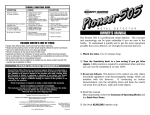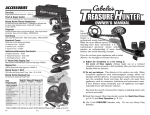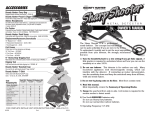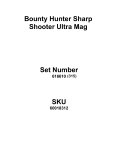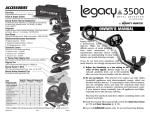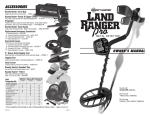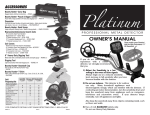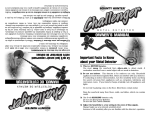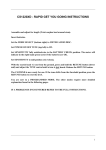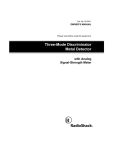Download Bounty Hunter PIONEER 505 Owner`s manual
Transcript
OWNER’S MANUAL The Pioneer 505 is a professional metal detector. The concepts and terminology can be quite unfamiliar if you are new to the hobby. To understand it quickly and to get the most enjoyment possible from your detector, we strongly recommend that you: 1) Watch the video. It is 21 minutes long. 2) Turn the Sensitivity knob to a low setting if you get false signals. A little practice is required to understand when and how you can use the sensitivity at or near 100%. 3) Do not use indoors. This detector is for outdoor use only. Many household appliances emit electromagnetic energy, which can interfere with the detector. If conducting an indoor demonstration, turn the sensitivity down and keep the searchcoil away from all floors, walls and metal objects. 4) Read this manual. Most importantly, review the Summary of Operating Modes and the Quick-Start Demo. 5) Use 9volt ALKALINE batteries only. TABLE OF CONTENTS TERMINOLOGY . . . . . . . . . . . . . . . . . . . . . . . . . . . . . . .3 ASSEMBLY . . . . . . . . . . . . . . . . . . . . . . . . . . . . . . . . . .4-5 BATTERIES . . . . . . . . . . . . . . . . . . . . . . . . . . . . . . . . . . .6 QUICK-START DEMO . . . . . . . . . . . . . . . . . . . . . . . . . . .7 BASIC OPERATION . . . . . . . . . . . . . . . . . . . . . . . . .8 & 9 SUMMARY OF OPERATING MODES . . . . . . . . . . . . . .10 LCD TARGET DISPLAY . . . . . . . . . . . . . . . . . . . . . . . . .11 DEPTH & BATTERY INDICATORS . . . . . . . . . . . . . . . .12 SENSITIVITY ADJUSTMENT . . . . . . . . . . . . . . . . . . . .12 AUDIO TARGET IDENTIFICATION . . . . . . . . . . . . . . .13 IN THE FIELD TECHNIQUES No-Motion Modes . . . . . . . . . . . . . . . . . . . . . . . . . .13 Motion Modes . . . . . . . . . . . . . . . . . . . . . . . . .14 & 16 4-INCH GOLD NUGGET COIL . . . . . . . . . . . . . . . . . . . .17 HEADPHONES . . . . . . . . . . . . . . . . . . . . . . . . . . . . . . .17 TROUBLE SHOOTING GUIDE . . . . . . . . . . . . . . . . . . .18 WARRANTY . . . . . . . . . . . . . . . . . . . . . . . . . . . . . . . . . .19 ACCESSORIES . . . . . . . . . . . . . . . . . . . . . . . . .Back Cover 2 TERMINOLOGY ELIMINATION Reference to a metal being "eliminated" means that the detector will not emit a tone, nor light up an LCD indicator, when a specified object passes through the coil’s detection field. DISCRIMINATION When the detector emits different tones for different types of metals, and when the detector "eliminates" certain metals, we refer to this as the detector "discriminating" among different types of metals. Discrimination is a fixed-start-point elimination system. NOTCH Notching is the elimination of an item, or range of items, within the metallic spectrum. We "notch-out" an object selectively. Objects to the left and right on the metallic spectrum are retained. Notching creates a variable rejection window. RELIC A relic is an object of interest by reason of its age or its association with the past. Many relics are made of iron, but can also be made of bronze or precious metals. IRON Iron is a common, low-grade metal that is often an undesirable target in certain metal detecting applications. Examples of undesirable iron objects are old cans, pipes, bolts, and nails. Sometimes, the desired target is made of iron. Property markers, for instance, can contain iron. Valuable relics can also be composed of iron; cannon balls, old armaments, and parts of old structures and vehicles can also be composed of iron. FERROUS Metals which are made of, or contain, iron. PINPOINTING Pinpointing is the process of finding the exact location of a buried object. Long-buried metals can appear exactly like the surrounding earth, and can therefore be very hard to isolate. PULL-TABS Discarded pull-tabs from beverage containers are the most bothersome trash items for treasure hunters. They come in many different shapes and sizes. We have incorporated special features into the detector to let you automatically eliminate the most common types, using the AutoNotch Mode. Since there are many different types, some must be "Notched-Out" manually. GROUND BALANCE Ground Balancing is the ability of the detector to ignore, or "see through," the earth’s naturally occurring minerals, and only sound a tone when a metal object is detected. WATERPROOF The searchcoil can be submerged in water. The control housing and cable-to-housing connection must, however, stay dry. COINSHOOTING Finding buried coins is the most popular metal detecting application. The most valuable are very old; take care in unearthing them to avoid damage. CACHE HUNTING Pronounced “cash”. A cache is a buried or hidden valuable stored inside a case, strong box, or bag. 3 EASY ASSEMBLY Assembling your Pioneer 505 Metal Detector is easy and requires no tools. Just follow these steps: 1 ● Using the supplied BOLT and KNURLED KNOB, attach the SEARCHCOIL to the LOWER STEM. 2 ● Press the button on the upper end of the LOWER STEM and slide the LOWER STEM into the UPPER STEM. Adjust the stem to a length that lets you maintain a comfortable upright posture, with your arm relaxed at your side. Maintain the SEARCHCOIL about 1 inch above the ground as you sweep. 3 ● Insert the coil’s plug into the matching connector on the control housing. Be sure the holes and pins line up correctly. Caution: Do not force the plug in. Excess force will cause damage. To disconnect the cable, pull on the plug. Do not pull on the cable. 4 CABLE LOWER STEM KNURLED KNOB COIL BOLT Wind the SEARCHCOIL cable around the stem. Leave enough slack in the cable to let you adjust the coil when you are hunting on uneven ground. Then tighten the knob at the end of the SEARCHCOIL. Note: To adjust the coil, simply loosen the knob. 4 ● SILVER BUTTON Connector on back of unit Body Connector Plug Detector Body S-Rod ASSEMBLY continued Adjusting the Armrest Most people will find the standard position of the armrest very comfortable. Very large forearms and short forearms (particularly children’s arms), can be accommodated by moving the armrest forward. The armrest may be moved forward or backwards by removing the single screw and nut, and then repositioning the 2-piece armrest. Users with shorter arms may find the armrest more comfortable in the forward position. In order to move the armrest backwards, the plastic plug must be removed from the aluminum tube. ARMREST CONTROL HOUSING S-ROD PLUG SILVER BUTTON Armrest Strap (optional accessory) The strap is available for purchase as a separate accessory. Some users prefer to use the strap when swing the detector vigorously, in order to hold the detector secure against the arm. The detector can also be used without the strap, with no compromise to detector balance and stability under most conditions. LOWER STEM SEARCHCOIL CABLE KNURLED KNOB BOLT SEARCHCOIL 5 BATTERIES IMPORTANT: Always use ALKALINE batteries for optimal performance. Always remove the batteries for prolonged storage. CHECK THE BATTERIES if your detector exhibits any of the following symptoms: 1 ● 2 ● 3 ● The unit does not turn on. Low speaker volume. Unable to tune detector with the discriminate knob. The Low Battery indicator light will come on and stay on whenever the batteries need replacing. It should flash momentarily when the Power Switch is turned on. IMPORTANT: Your Pioneer 505 metal detector requires two 9-Volt ALKALINE batteries. Follow these steps to install the batteries. 1 Carefully remove the battery ● compartment door by pressing the release clip on the right side of the door. 2 Snap one battery onto each of ● the terminals and place the batteries inside the compartment. 3 ● Replace the compartment door by carefully inserting opposite side of clip first. Then press down on clip side until battery door snaps into place. Release Clip DO NOT MIX OLD AND NEW BATTERIES 6 QUICK-START DEMO I. SUPPLIES NEEDED • Nickel • Quarter • A small piece of aluminum foil • Dime • A Nail • A large screwdriver or other large iron object • A Zinc Penny (dated after 1982) II. POSITION THE DETECTOR a. Place the detector on a table, with the searchcoil hanging over the edge. (or better, have a friend hold the detector, with the coil off the ground) b. Keep the searchcoil away from walls, floors, and metal objects. c. Remove watches, rings and other jewelry or metal objects from hands and wrists. d. Turn off appliances or lights that cause electromagnetic interference. e. Pivot searchcoil to a position parallel to the ground. III. POWER UP a. Turn the detector on and turn the sensitivity knob to the 3:00 position. b. Press ALL METAL button. c. Press the GroundTrac button. IV. HOLD OBJECTS OVER SEARCHCOIL a. Notice the single tone, regardless of the object. b. Motion is not required. The detector will emit sound whenever a metal object is over the searchcoil. V. ENTER DISCRIMINATION MODE a. Press the DISC button. b. Move the Disc/Notch Knob 100% counterclockwise. VI. WAVE OBJECTS OVER SEARCHCOIL a. Wave coins with flat surface parallel to coil. This is how you’ll find them buried in the ground. b. Notice the different tones. c. Watch the LCD indicator for depth and target identification. VII. DISCRIMINATE a. Waive the nail and slowly turn the Disc/Notch Knob clockwise until the nail is eliminated. b. Continue eliminating objects one-by-one, by turning the Disc/Notch Knob clockwise as you wave each object. Stop turning after the zinc penny is eliminated. c. The objects will be eliminated in this order: 1) Nail 2) Screw Driver 3) Foil 4) Nickel 5) Penny VIII. NOTCH a. Press the Notch button. b. Position the Disc/Notch Knob so that the penny is eliminated. c. Notice that the nickel is now detected. The penny has been "notched-out." 7 BASIC OPERATION TURN THE DETECTOR ON Click the left knob to the on position. Three tones will sound. The detector automatically enters the DISC Mode. NO-MOTION ALL METAL MODE To operate in this mode: • Hold the searchcoil over the ground surface, about 1/2 inch. • Press ALL METAL, then press GROUND TRAC Button. The detector will emit only one monotone sound, regardless of the type of metal detected. If the detector emits a constant tone, retune the detector with the searchcoil just above the ground surface. Make sure that the ground area chosen for tuning the detector does not contain metal; if unsure, switch into DISC mode and verify that the detector does not emit tones as you sweep the coil over the chosen spot. Ground conditions can change over short distances. Until you become familiar with the detector’s volume level, retune the detector periodically by pressing the GroundTrac button. Temperature changes also require retuning. If the detector emits a constant tone, or loses sensitivity, retune. If you have stored the detector indoors and move outdoors immediately to a different temperature environment and begin detecting, retune the detector periodically until the coil temperature stabilizes. This retuning is only necessary in the ALL METAL Mode. MOTION ALL METAL Mode To operate in this mode: • Turn the right knob, Disc/Notch, 100% counterclockwise, to the off position. • Press the DISC button. • Reduce the Sensitivity Control to the 2:00 or 3:00 position. • Sweep the coil over the surface of the ground. The detector will emit one of three tones, depending on the type of metal detected. The top display will indicate the type of metal targeted. The bottom display will indicate the depth, in inches, of coin-sized objects. A worthwhile target is evidenced by a consistent tone, and a repeatable target and depth indication as you sweep back and forth over the same spot more next page 8 BASIC OPERATION continued on the ground. Non-repeatable tones indicate the presence of trash objects or highly oxidized metals. You can increase the level of sensitivity, depending on the ground conditions. If the detector emits false signals, simply reduce the Sensitivity until the false signals cease. The detector will work well with the Sensitivity in the 2:00 or 3:00 position, but higher Sensitivity settings will increase depth detection. If you need maximum depth detection, operate in the ALL METAL Mode, which allows for higher Sensitivity control settings. DISCRIMINATION Mode To operate in this mode: • Press the DISC button. • Reduce the Sensitivity Control to the 2:00 or 3:00 position. • Sweep the coil over the surface of the ground. • Turn the right knob, Disc/Notch, to eliminate unwanted items from detection as illustrated to the right: NOTCH Mode To operate in this mode: • Press the NOTCH button. • Use the Disc/Notch Knob to eliminate medium tone trash items from detection, but still retain low and high tone valuables. AUTONOTCH Mode To operate in this mode: • Press the AUTONOTCH button. • Most pull-tabs and medium tone trash items are automatically eliminated. • The Disc/Notch Knob operates as in the NOTCH mode. To change into any mode at any time, simply press the desired button. The GroundTrac button only functions when in the All Metal Mode. 9 SUMMARY OF OPERATING MODES I. NO-MOTION ALL METAL MODE • Deepest Seeking Mode • No motion is required • All metals will be detected • One tone only • Manual Ground Balance: User must tune and retune with the GroundTrac button. To Operate: 1) Press All Metal button. 2) Press GroundTrac button, and re-tune as necessary. Applications: Pinpointing Objects located in motion modes Relic Hunting Cache Hunting Household applications: finding lost items, locating property markers II. MOTION ALL METAL MODE • Motion Required • All metals will be detected • Three-tone Audio Target Identification To Operate: 1) Press DISC button. 2) Keep Disc/Notch Knob 100% counterclockwise. 3) Reduce Sensitivity Knob in event of false signaling. Applications: Relic Hunting Cache Hunting Household applications: finding lost items, locating property markers III. DISCRIMINATION MODE • • • • • Motion Required Three-tone audio target identification Disc/Notch Knob allows user to eliminate unwanted items. Discrimination is a fixed-start-point system. Items are cumulatively eliminated. As you turn the knob farther clockwise, more objects are eliminated, including the first items eliminated. • Reduce Sensitivity if the detector emits false or non-repeatable signals. • Automatic Ground Balance: detector automatically adjusts to ground mineralization as you sweep the coil. To Operate: 1) Press DISC button 2) Move Disc/Notch Knob to desired setting. 3) Reduce Sensitivity Knob in event of false signaling. Applications: Coin-Shooting Jewelry Hunting IV. NOTCH MODE • Automatically eliminates all ferrous objects. • Disc/Notch Knob allows user to eliminate medium-tone trash items, but retain low and high-tone valuables. To Operate: 1) Press NOTCH button. Other Operations and Applications: same as Discrimination Mode. V. AUTONOTCH MODE • Automatically eliminates all ferrous objects. • Automatically eliminates most pull-tabs. • Disc/Notch Knob allows user to eliminate medium-tone trash items, but retain low and high-tone valuables. To Operate: 1) Press AUTONOTCH button Other Operations and Applications: same as Discrimination Mode. 10 LCD TARGET DISPLAY -Motion modes only READING THE DISPLAY The LCD Target Display is accurate in the Motion Modes only. The Liquid Crystal Display (LCD) shows the PROBABLE identification of the targeted metal, as well as the PROBABLE depth of the target, in inches. Pass the searchcoil repeatedly over a target, and observe the target readout. The detector will register a repeated, unchanging target identification when a buried target has been located and identified. If, upon repeated passes over the same spot, the target identification reads inconsistently, the target is probably a trash item, or oxidized metal. With practice, you will learn to unearth only the repeatable signals. The segment identifications are highly accurate, when detecting the objects described on the label. For example, if you pass the coil repeatedly over a nickel, your detector will repeatedly register a nickel. However, if you repeatedly register a nickel, for an unknown buried object, you could be detecting some other metallic object with the same magnetic signature as a nickel. GOLD TARGETS Gold objects will register on the left side of the LCD scale. Gold flakes will register under Iron/Foil Small gold items will register under Pull Tab. Medium-sized gold items will register under S-caps. Large gold items will register as Zinc 1¢. SILVER TARGETS: Silver objects will register to the right of the scale, under 25¢, 50¢, or $1, depending on the size of the object. The larger the object, the farther to the right it will register. IRON/FOIL: All sizes of iron and aluminum objects will register on the far-left side of the scale. This could indicate a worthless item such as a nail, or a more valuable historic iron relic. PULL TAB: All older pull tabs from beverage cans will register here. Most newer pull tabs will register here. Many gold rings will also register here. S-CAPS: Older screw caps from glass bottles will register here. Large gold rings, like a class ring, could also register here. Some non-U.S. coins of recent vintage will also register here. 1¢ ZINC: Newer pennies (post-1982) will register here. Many non-U.S. coins of recent vintage will also register here. 10¢: Dimes and pre-1982 pennies will register here. Older, pre-1982, pennies are composed of copper, which has a metallic signature similar to a dime. Caution: The target indications are visual references. Many other types of metal can fall under any one of these categories. You will experience a trash-to-treasure ratio when treasure hunting. The more you practice, the lower you will push your trash-totreasure ratio. While the Pioneer 505 will eliminate or indicate the presence of most common trash items, it is impossible to accurately classify ALL buried objects. The LCD provides a visual reference to minimize the detection of trash objects. By using the target ID in conjunction with discrimination control and the threetone audio identification system (discussed later), you can further reduce the trash-to-treasure ratio. 11 BATTERY/ DEPTH INDICATORS & SENSITIVITY ADJUSTMENT BATTERY INDICATOR: SENSITIVITY ADJUSTMENT: The LOW BATT indicator will flash as the unit is powered on. If the indicator comes on and stays on, replace the batteries. The principle use for the SENSITIVITY knob is to eliminate ELECTROMAGNETIC INTERFERENCE (EMI). EMI is both naturally-occurring and man-made. Common sources of EMI are power lines, both suspended and buried, and broadcasting antennas. Machinery, when in operation, can also produce EMI. DEPTH INDICATOR: The Depth Indicator is accurate for coin-sized objects. It indicates the depth of the target, in inches. Large and irregularly-shaped objects will yield less reliable depth readings When passing over an object, the depth indicator will light up and stay illuminated until another object is scanned. Pass repeatedly over the suspected target and pause briefly at the end of each sweep to read your display. Repeated indication at the same depth level indicates an accurate target detector. If the depth indication varies with each sweep, try sweeping at different angles; there may be more than one target present. With practice, you will learn the difference between accurate readings, multiple targets, and highly erratic readings which evidence trash or irregularly shaped objects. Depth indicator locked on 8 inches 12 EMI comes from most household appliances, so YOUR DETECTOR CAN BEHAVE VERY ERRATICALLY INDOORS. If you want to test it indoors, turn off the TV and microwave. If you have lights with dimmer switches, also turn these off; dimmer switches can produce lots of EMI. If your detector chatters with the SENSITIVITY knob in the 100% clockwise position, reduce the sensitivity until the chatter stops (usually to the 1:00 or 3:00 position). If you suspect the presence of deeper targets underneath a shallower target, reduce the SENSITIVITY to eliminate the detection of the deeper target to properly locate and identify the shallower target.: IN THE FIELD TECHNIQUES - No-motion modes In the No-Motion All Metal Mode, coil sweep technique is not important. Rather, user retuning is critical. The detector does not automatically adjust to changing ground and environmental conditions; the operator is required to make the adjustment. If the detector sounds a constant tone over all areas of the ground, retune the detector by pressing the GroundTrac button. RETUNING Keep the coil still, just above the ground surface, and press the GroundTrac button. Make sure that the spot on the ground you chose for tuning did not contain metal; pass over the area with the coil again to insure that the detector does not emit a tone. TEMPERATURE CHANGE If the detector moves from one temperature environment to another, or if the temperature changes, you must retune the detector until the temperature stabilizes. If you move from a cooler to a warmer environment, the detector may emit a constant tone; if so, retune. If you move from a warmer to cooler environment, the detector may lose sensitivity; if so, retune. PINPOINTING How To Pinpoint Targets Using The ALL METAL Mode When you’ve discovered a target you wish to dig, do the following: 1. Hold the searchcoil about half an inch above the ground, off to the side of where you think the target probably is. 2. Tap the ALL METAL touchpad button. This will put you into the All Metal Pinpoint mode. NOTE: unlike the other modes, this mode does not require the searchcoil to be in motion to detect a target. 3. Lift the searchcoil slightly, and pass it over the target. The sound will be loudest over the center of the target. To Narrow It Down Further: 4. Now that you know about where the target is, again lower the searchcoil to about half an inch above the ground, near the center of the target but not right over the top. Tap the button again. The sound will instantly go away. 5. Lift the searchcoil slightly and move it horizontally over the target. The audible response zone will be much narrower. If you move the searchcoil around right and left and also forward and back, making an “X” pattern over the target, you can determine the location of the target usually within an inch or two. NOTE: if at any time it seems like the signal may be drifting, just tap the Ground-Trac button. This restores the signal to its zero level. Detection Field The No-Motion Mode’s detection field depends on the size of the target. Large Objects After detecting a target, lift the coil off the ground to a distance where you hear the faintest tone. Move the coil over the ground at this height. If the tone does not fade, you have detected a large or irregularly shaped object. Outline the object with slow coil movements. If you can outline an area larger than the size of the inside coil, you then have a large target, or several targets. Large objects can be detected when they enter the range of the outside coil. 13 AUDIO TARGET ID -Motion modes only In the DISC, NOTCH or AUTONOTCH modes, the detector emits three distinct tones, which classify metal objects into categories IRON & STEEL: In the DISCRIMINATION mode most iron and steel objects will induce a low tone. Highly oxidized iron can induce a high tone, depending on the Disc/Notch control setting. For instance, some rusted bottle caps will induce a high tone and indicate to the right of the LCD target display. GOLD: Gold objects will induce a low or medium tone, depending on their sizes. Very small gold objects will indicate on the left-most segment. Large gold objects will read under the Zinc segment. If you are gold prospecting, you will usually be looking for natural gold in an area which it does not contain much trash, and can therefore ignore the specific segment descriptions. PULL TABS: Pull tabs are the most bothersome trash items for detectorist. Most will induce a medium tone. Most will be eliminated automatically in the AUTO NOTCH mode, or alternatively be manually “notched out” in NOTCH mode with the Disc/Notch control. The older pull tabs (those not attached to the can after opening) are sometimes broken in half; these broken tabs can induce low tones. Highly oxidized pull tabs can also induce high tones. It can be very difficult to differentiate pull tabs from gold rings. When they both induce medium tones, you might notice a “double beep” from a gold ring but a “single beep” from pull tabs. To achieve this distinction, sweep the searchcoil very slowly, and at different angles. Two tones might signal as the detector passes over each side of the round ring. COPPER, SILVER & BRASS: Most valuable coins are composed of these metals and will usually induce a high tone. Valuable objects other than coinage can also be composed of copper, silver and brass. LOW TONE MEDIUM TONE HIGH TONE Nails & Bottle Caps, Gold & Nickel Old & New Pull Tabs, Zinc, Pennies (Post 1982), Larger Gold Objects Copper, Silver & Brass Copper Pennies (Pre 1982) Audio Target Identification (ATI) classifies metals into three categories. 14 IN THE FIELD TECHNIQUES - Motion modes PINPOINTING COIL MOVEMENT Accurate pinpointing takes practice and is best accomplished by “X-ing” the target area. When swinging the coil, be careful to keep it level with the ground about one inch from the surface. Never swing the coil like a pendulum. 1. Once a buried target is indicated by a good tone response, continue sweeping the coil over the target in a narrowing side-to-side pattern. 2. Take visual note of the place on the ground where the “beep” sounds. 3. Stop the coil directly over this spot on the ground. 4. Now move the coil straight forward and straight back towards you a couple of times. 5. Again make visual note of the spot on the ground at which the “beep” sounds. 6. If needed, “X” the target at different angles to “zero in” on the exact spot on the ground at which the “beep” sounds. 7. Use All Metal mode (p8) for more accurate pinpointing. When pinpointing a target, try drawing an “X”, as illustrated, over where the tone is induced. WRONG CORRECT The coil should be swung in a halfcircle movement as illustrated here. Repeat this motion every step you take to guarantee that the area is being covered thoroughly. 15 IN THE FIELD TECHNIQUES - Motion modes After selecting your operating mode, swing the searchcoil gently side-to-side, slightly overlapping each sweep as you move forward. Make sure you keep your searchcoil approximately 1 inch above the ground as you search. Raising it in the sweep, or at the ends of your sweep, will cause false readings. Move slowly; hurrying will only cause you to miss targets. Most good objects will respond with a good repeatable signal. If a signal does not repeat after swinging the coil directly over the suspected target a few times, it is more than likely trash metal. False signals can be caused by trashy ground, electrical WHAT READS LIKE THIS 16 interference, or by large irregular trash objects. These signals are easily recognized by their often broken or non-repeatable nature. The Pioneer 505 is a very sensitive and deep-seeking detector. It will respond loudly to many targets that other detectors would only detect with a weak signal. Because of this, trash-induced signals and other sources of interference may cause signals that seem confusing. The key to managing these false signals is to dig only those targets that emit a strong repeatable signal. As you sweep the searchcoil back and forth over the ground, learn to recognize the difference between the signals that occur at random and signals that are stable and repeatable. When searching very trashy ground, it is best to scan small areas with slow, short overlapping sweeps. To prevent erratic signals and difficult pinpointing in trashy areas, consider purchasing the Bounty Hunter 4-Inch Gold Nugget Coil System. …MAY ACTUALLY BE THIS 4-INCH GOLD NUGGET COIL The standard 8-inch coil is great for most detecting applications. In special situations, a smaller coil is needed. Tight Spaces The 4-inch coil can fit into tight spaces. Black Sand “Sees through” black sand, or other highly mineralized soils, because the ratio of metal to detection area is higher. Perfect for gold prospecting. Trashy Areas Narrow detection field can better separate objects. USING HEADPHONES Using headphones (not included) improves battery life, and prevents the sounds from annoying bystanders. It also allows you to hear subtle changes in the sound more clearly, particularly if searching in a noisy location. For safety reasons, do not use headphones near traffic or where other dangers are present. This device is to be used with interconnecting cables/headphone cables shorter than three meters. 17 TROUBLESHOOTING TROUBLESHOOTING GUIDE SYMPTOM CAUSE Detector chatters • Using detector or beeps erratically indoors • Using detector near power lines • Using 2 detectors in close proximity • Highly oxidized buried object • Environmental electromagnetic interference SOLUTION • Use detector outdoors only • Move away from power lines • Keep 2 detectors at least 30’ apart • Only dig up repeatable signals • Reduce sensitivity until erratic signals cease Constant low tone • Discharged batteries • Replace batteries or constant repeating • Wrong type of • Use only 9V tones batteries alkaline batteries LCD does not lock • Multiple targets on to one target ID present or detector emits • Highly oxidized multiple tones target • Sensitivity set too high No power, no sounds 18 • Move coil slowly at different angles • Reduce sensitivity • Dead batteries • Replace batteries • Cord not connected • Check connections securely • Not moving • Sweep searchcoil Searchcoil from side-to-side TREASURE HUNTER’S CODE OF ETHICS: • Always check Federal, State, County and local laws before searching. • Respect private property and do not enter private property without the owner’s permission. • Take care to refill all holes and leave no damage. • Remove and dispose of any and all trash and litter found. • Appreciate and protect our inheritance of natural resources, wildlife and private property. • Act as an ambassador for the hobby, use thoughtfulness, consideration and courtesy at all times. • Never destroy historical or archaeological treasures. • All treasure hunters may be judged by the example you set; always conduct yourself with courtesy and consideration of others FIRST TEXAS PRODUCTS, LLC 5-YEAR LIMITED WARRANTY Bounty Hunter Metal Detectors are warranted against defects in workmanship or materials under normal use for five years from date of purchase to the original user. Liability in all events is limited to the purchase price paid. Liability under this Warranty is limited to replacing or repairing, at our option, any Bounty Hunter Detector returned, shipping cost prepaid, to First Texas Products, LLC. Damage due to neglect, accidental damage or misuse of this product is not covered by this warranty. Proof of purchase is required to make a claim under this warranty. NOTE TO CUSTOMERS OUTSIDE THE U.S.A. This warranty may vary in other countries, check with your distributor for details. Warranty does not cover shipping costs According to FCC part 15.21 Changes or Modifications made to this device not expressly approved by the party responsible for compliance could void the users authority to operate this equipment. This device complies with FCC Part 15 Subpart B Section 15.109 Class B. Copyright ©2012 by First Texas Products, L.L.C. All rights reserved, including the right to reproduce this book, or parts thereof, in any form, except for the inclusion of brief quotations in a review. Published by First Texas Products, L.L.C. Bounty Hunter® is a registered trademark of First Texas Products, L.L.C. The BOUNTY HUNTER PIONEER series of metal detectors is not associated or connected in any way with Pioneer Corporation or its PIONEER brand audio and video products or other products. www.detecting.com First Texas Products L.L.C. 1465-H Henry Brennan • El Paso, TX 79936 • (915) 633-8354 MADE IN U.S.A. 19 ACCESSORIES Carry Bag Rugged double-stitched construction – CBAG-W Pouch & Digger Combo Pouch with 2 large pockets & 9” heavy duty digging tool. – TP-KIT-W Bounty Hunter Stereo Headphones Use with Bounty Hunter metal detectors. Lightweight and adjustable with true stereo sound, adjustable volume, 1/8 jack with 1/4 adaptor, 4’ cable. – HEAD-W Pin Pointer Pinpoints the exact location of buried metal objects. Audio signal indicator and vibrator. Runs on (1) 9-Volt Battery. – PIN POINTER-W Sand Scoop Large scoop with filtering holes. Made of strong plastic. – SAND SCOOPBH Replacement/Accessory Search Coils 10” Magnum Coil – 10COIL 8” Replacement Standard Coil – 8COIL-N 4” Gold Nugget Coil – 4COIL Coil Covers Protect your coil from abrasion and damage. 10” Coil Cover – 10COVER 8” Coil Cover – 8COVER-N 4” Coil Cover – 4COVER 9” Heavy-Duty Digging Tool Metal blade with comfortable plastic handle and depth gauge. – TROWEL-2 Digging Tool Light and practical wide blade digging tool. – TROWEL-W Bounty Hunter Baseball Cap One size fits all, with Bounty Hunter® logo. – BHCAP Bounty Hunter T-Shirt 100% cotton with Bounty Hunter® Logo. Sizes: LG, XL & XXL – BHTSHIRT Gold Prospecting Kits FOR COMPLETE DETAILS VISIT WWW.DETECTING.COM • 1-800-413-4131 M505PL 032213




















